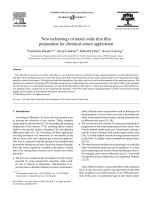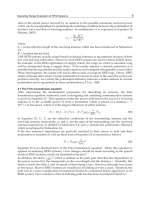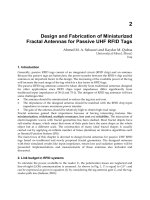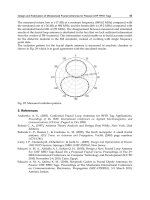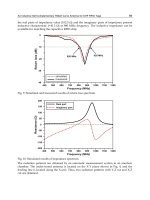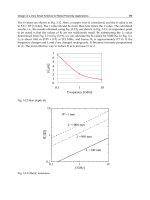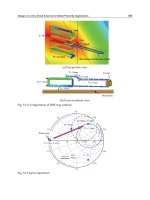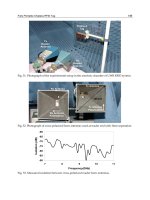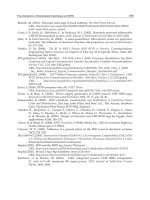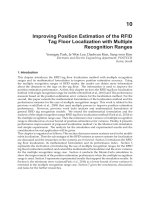identification, design and synthesis of oxygenated hydrocarbon-based carbon dioxide-soluble polymers for chemical and petroleum engineering applications
Bạn đang xem bản rút gọn của tài liệu. Xem và tải ngay bản đầy đủ của tài liệu tại đây (3.67 MB, 187 trang )
IDENTIFICATION, DESIGN AND SYNTHESIS OF OXYGENATED HYDROCARBON-
BASED CO
2
-SOLUBLE POLYMERS FOR CHEMICAL AND PETROLEUM
ENGINEERING APPLICATIONS
by
Lei Hong
B.S., East China University of Science and Technology, 1996
M.S., East China University of Science and Technology, 1999
Submitted to the Graduate Faculty of
School of Engineering in partial fulfillment
of the requirements for the degree of
Doctor of Philosophy
University of Pittsburgh
2006
UMI Number: 3223980
3223980
2006
UMI Microform
Copyright
All rights reserved. This microform edition is protected against
unauthorized copying under Title 17, United States Code.
ProQuest Information and Learning Company
300 North Zeeb Road
P.O. Box 1346
Ann Arbor, MI 48106-1346
by ProQuest Information and Learning Company.
UNIVERSITY OF PITTSBURGH
SCHOOL OF ENGINEERING
This dissertation was presented
by
It was defended on
March 29, 2006
and approved by
Dr. Eric J. Beckman, Professor, Chemical and Petroleum Engineering Department
Dr. J. Karl Johnson, Professor, Chemical and Petroleum Engineering Department
Dr. Toby Chapman, Associate Professor, Department of Chemistry
Dissertation Director: Dr. Robert M. Enick, Chairman and Professor, Chemical and Petroleum
Engineering Department
ii
Copyright © by Lei Hong
2006
iii
ABSTRACT
IDENTIFICATION, DESIGN AND SYNTHESIS OF OXYGENATED
HYDROCARBON-BASED CO
2
-SOLUBLE POLYMERS FOR
CHEMICAL AND PETROLEUM ENGINEERING APPLICATIONS
Lei Hong, Ph.D.
University of Pittsburgh, 2006
Over the past two decades the use of sub/supercritical CO
2
has received much attention as a
green alternative to organic solvents for chemical processes because of its pressure-tunable
physicochemical properties and economic advantages. However the advantages are diminished
because of a relative narrow range of CO
2
-soluble materials. The goal of this work is to identify,
design and synthesize oxygenated hydrocarbon-based CO
2
-soluble polymers that are able to
serve as construction blocks for copolymers, dispersants, surfactants, and thickeners. Without
concerning on the cost and the environmental persistence like fluorinated materials, the
inexpensive and environmentally benign materials would significantly enhance the viability of
sub/supercritical CO
2
-based technology. Based on both experimental heuristics and ab initio
simulation of molecular modeling (performed by Dr. Johnson’s group), we proposed specific
new polymer structures: poly (3-acetoxy oxetane) (PAO), poly (vinyl methoxymethyl ether)
(PVMME), poly (vinyl 1-methoxyethyl ether) (PVMEE), and cellulose triacetate (CTA)
oligomers. Phase behavior studies were also performed with novel CO
2
-philic compounds
containing vinyl acetate, propylene glycol, or multiple tert-butyl groups.
iv
PAO, PVMME and PVMME were soluble in CO
2
, but not as soluble as poly (vinyl
acetate). Oligomers of cellulose triacetate with as many as four repeat units solubilized into
dense CO
2
less than 14 MPa in the concentration range of 1-5 wt%. Phase behaviors of more
than twenty compounds in dense CO
2
were studied in this project. A new type of phase behavior
for solid CO
2
-philes that melt and dissolve in CO
2
was detailed using a model binary mixture of
β-D-maltose octaacetate and CO
2
. Copolymers of tetrafluoroethylene (TFE) and vinyl acetate
(VAc) exhibited lower miscibility pressures than either of the homopolymers, probably due to
quadradentate binding configurations with CO
2
. Phase behavior investigation of poly (propylene
glycol) (PPG) monobutyl ether in CO
2
demonstrated ether-CO
2
interactions should receive as
much attention as carbonyl-CO
2
interactions when designing CO
2
-philic functional groups.
1,3,5-tri-tert-butylbenzene and 2,4,6-tri-tert-butylphenol were both extraordinarily soluble in
CO
2
, and are excellent candidates for CO
2
-soluble sand binders.
In summary, although a new CO
2
thickener was not identified, new non-fluorous CO
2
-
soluble materials were identified, which were, in general, acetate-rich with flexible chains, weak
self-interactions, and multidentate interaction between CO
2
and solute functional groups.
v
TABLE OF CONTENTS
TABLE OF CONTENTS VI
LIST OF TABLES X
LIST OF FIGURES XII
ACKNOWLEDGEMENT XVII
1.0 INTRODUCTION 1
1.1 PROPERTIES OF SUPERCRITICAL CARBON DIOXIDE 2
1.2 SUPERCRITICAL-CARBON DIOXIDE-BASED MATERIAL SCIENCE
APPLICATIONS 5
1.2.1 Polymerization 5
1.2.2 Formation of Polymer Blends 8
1.2.3 Encapsulation of Pharmaceuticals 9
1.2.4 Scaffolds for Tissue Engineering Applications 10
1.3 CO
2
THICKENING AGENTS 11
1.3.1 Exploratory Research on Decreasing the Mobility of CO
2
16
1.3.2 Success of Fluorinated Copolymers as CO
2
Thickeners 19
1.4 RESEARCH OBJECTIVES 27
vi
2.0 BACKGROUND 29
2.1 SOLVENT PROPERTIES OF CO
2
29
2.2 THERMODYNAMIC FUNDAMENTALS OF SUB/SUPERCRITICAL CO
2
SOLUTION 31
2.3 PROGRESS IN IDENTIFICATION OF NON-FLUOROUS/SILICONE
CO
2
SOLUBLE FUNCTIONAL GROUPS 35
2.3.1 Experimental Study 35
2.3.2 Empirical Heuristics of Designing Oxygenated Hydrocarbon-Based
CO
2
-Soluble Functional Groups 42
2.4 MODELING AIDED DESIGN
131
44
2.5 PHASE BEHAVIOR MEASUREMENTS 47
2.6 VISCOSITY MEASUREMENT 51
2.7 SYNTHESIS CHARACTERIZATIONS 54
3.0 POLYMERS DESIGNED BY MODELING COMPUTATION 55
3.1 POLY(VINYL ACETATE) 55
3.2 POLY(3-ACEOXY OXETANE) 58
3.2.1 Modeling Design 58
3.2.2 Preparation 60
3.2.3 Phase Behavior Study 64
3.3 POLY(VINYL ETHER)S WITH ACETAL GROUPS 65
3.3.1 Modeling Design 65
3.3.2 Preparation 66
vii
3.3.3 Phase Behavior Study 70
3.4 CONCLUSIONS 71
4.0 PERACEYLATED CELLULOSE TRIACETATE OLIGOMERS 72
4.1 LITERATURE REVIEW 72
4.2 CELLULOSE TRIACETATE OLIGOMERS 75
4.2.1 Design of Cellulose Triacetate Oligomers 75
4.2.2 Synthesis 77
4.2.3 Phase Behavior Study 79
4.3 CONCLUSIONS 84
5.0 PHASE BEHAVIOR STUDY 86
5.1 GLOBAL PHASE BEHAVIOR FOR CO
2
-PHILIC SOLIDS 86
5.1.1 Introduction 86
5.1.2 Results and Discussion 88
5.1.3 Conclusions 94
5.2 SOLUBILITY OF LINEAR POLY(TETRAFLUOROETHYLENE-CO-
VINYL ACETATE) IN DENSE CARBON DIOXIDE 95
5.2.1 Introduction 95
5.2.2 Results and Discussion 97
5.2.3 Conclusions 104
5.3 PHASE BEHAVIOR OF POLYPROPYLENE GLYCOL IN DENSE
CARBON DIOXIDE 105
5.3.1 Introduction 105
viii
5.3.2 Results and Discussion 109
5.3.3 Conclusions 112
5.4 SOLUBILITY OF TERT-BUTYLATED AROMATICS IN DENSE
CARBON DIOXIDE 113
5.4.1 Introduction 113
5.4.2 Results and Discussion 116
5.4.3 Conclusions 122
6.0 VISCOSITY STUDY 124
6.1 SAMPLES FROM AIR PRODUCTS AND CHEMICALS 124
6.2 VISCOSITY OF SUGAR ACETATE IN CO
2
126
7.0 SUMMARY 129
8.0 FUTURE WORK 133
APPENDIX A 137
APPENDIX B 157
BIBLIOGRAPHY 160
ix
LIST OF TABLES
Table 1.1 Physical properties of a gas, liquid, and supercritical fluid (SCF)
4,5
3
Table 1.2 Critical properties of various solvents
5,6
4
Table 1.3 Formulas of fluorinated CO
2
thickeners 21
Table 2.1 Summary of prospective CO
2
-philic functionalities 35
Table 3.1 Binding configurations and energies for IPA/ CO
2
136
56
Table 3.2 T
g
of PVA, PVMME, and PVMEE 69
Table 4.1 Parameters of wet-column separation 79
Table 5.1 Bulk Analysis of TFE-VAc copolymers 98
Table 5.2 Physical properties of butylated compounds and linear compound (Aldrich) 115
Table 6.1* Comparison of neat CO
2
viscosity obtained by falling cylinder viscometer with
reference data
180
125
Table 6.2* Viscosities of neat CO
2
and S1, S2, and S3 in CO
2
at 298 K and 10 wt% 125
Table 6.3* Viscosity of neat CO
2
and galactose pentaacetate solutions at 313 K and 17.24 MPa
(2500 psi) 127
Table 8.1 Thickening candidates with phenyl groups 135
Table 8.2 Proposed amino groups for CO
2
thickening groups 136
Table B.1 Falling cylinder viscometer experimental data for neat CO
2
at 298 K with a fixed
falling distance of 0.05 m 158
x
Table B.2 Experimental data of Air Products and Chemicals’ samples at 298 K and 10 wt% with
a fixed falling distance of 0.02 m 159
Table B.3 Experimental data of β-D-galactose pentaacetate at 313K and 17.24 MPa with a fixed
falling distance of 0.05 m 159
xi
LIST OF FIGURES
Figure 1.1 Phase behavior of supercritical CO
2
and H
2
O 3
Figure 1.2 Viscosity of CO
2
as a function of temperature and pressure
73
14
Figure 1.3 CO
2
flooding in a typical reservoir: (a) “fingering” phenomena without mobility
control, (b) CO
2
flows with thickeners 15
Figure 1.4 Viscosity of PFOA in CO
2
at 323K under different concentrations.
88,89
20
Figure 1.5 CO
2
solubility of PHFDA-xPSt copolymers at 298K
91
23
Figure 1.6 CO
2
viscosity enhancement achieved with the fluoroacrylate-styrene copolymers
91
23
Figure 1.7 π-π stacking of the aromatic phenyl groups, (a) an overview structure; (b) a close view
structure
87
25
Figure 1.8 Effect of shear rate and concentration on the viscosity of fluoroacrylate-styrene
copolymer solution in CO
2
; Glass tube inside radius=1.588 cm; copolymer of 29mol% Styrene-
71mol% fluoroacrylate; T=298K; P=34 MPa.
92,98
26
Figure 2.1 Comparison of the partial charges on the individual atoms of H
2
O (A) and CO
2
(B)
with the charges derived by fitting the electrostatic potentials (CHELPG charges) in electrons
calculated at the MP2/aug-cc-pVDZ level.
109
30
Figure 2.2 Schematic diagram of interactions between CO
2
and CO
2
-philic group, (a) CO
2
as a
Lewis acid (C=OxxxC); (b) CO
2
acts as a Lewis base (C−HxxxO) 31
Figure 2.3 Cloud point pressures at ~5% polymer concentration and 298 K for binary mixtures of
CO
2
with polymers as a function of number of repeat units based on Mw, where PFA, PDMS,
PVAc, PLA, PMA and PACD represent poly(fluoroalkyl acrylate), poly(dimethyl siloxane),
poly(vinyl acetate), poly(lactic acid), poly(methyl acrylate) and per-acetylated cyclodextrin,
respectively.
119,123
41
xii
Figure 2.4 Schematic of experimental apparatus for phase behavior study with a high pressure,
variable volume, windowed cell (D.B. Robinson Cell) 48
Figure 2.5 Detailed drawing of a high pressure, windowed, stirred, variable-volume view cell . 49
Figure 2.6 Schematic diagram for a falling cylinder viscometer 52
Figure 3.1 Structure of poly(3-acetoxy oxetane), PAO 58
Figure 3.2 Three dimensional view of methoxy-isopropyl acetate, MIA 59
Figure 3.3 Three multiple binding geometry of CO
2
with methoxy isopropyl acetate 60
Figure 3.4 Synthesis scheme for monomer 3-acetoxyoxetane
140,141
61
Figure 3.5 Synthesis scheme for poly(3-acetoxy oxetane) (PAO, Polymerization II) 62
Figure 3.6 Synthesis scheme for poly(3-acetoxy oxetane) (PAO, Polymerization II) 63
Figure 3.7 Pressure-composition diagram for CO
2
+ poly(3-acetoxy oxetane) system at 298 K. 64
Figure 3.8 Structure of poly(vinyl methoxymethyl ether) (PVMME) 65
Figure 3.9 Optimized binding geometry of CO
2
with acetal group 66
Figure 3.10 Synthesis scheme for poly(vinyl methoxymethyl ether) and poly(vinyl 1-
methoxyethyl ether) 67
Figure 3.11 Pressure-composition diagram for CO
2
+ poly(vinyl ether) systems at 298 K 70
Figure 4.1 Pressure-composition phase diagram for the CO
2
+AGLU/BGLU/BGAL at 313K
112
73
Figure 4.2 Pivaloylysis of cellulose triacetate
152
76
Figure 4.3 Composition tracking of every CTA oligomer during pivaloylysis
152
77
Figure 4.4 Pressure-composition diagram for CO
2
+ CTA oligomer system at 298 K 81
Figure 4.5 General pressure-composition (P-x) phase diagram for classic sub/supercritical CO
2
+
heavy solid system
7
82
xiii
Figure 4.6 General pressure-composition (P-x) phase diagram for the novel sub/supercritical CO
2
+ heavy solid system
113
83
Figure 4.7 General pressure-composition (P-x) phase diagram for the novel sub/supercritical CO
2
+ heavy solid system
113
84
Figure 5.1 Structure of β-D-maltose octaacetate 88
Figure 5.2 Pressure-composition diagram for the carbon dioxide (1) + maltose octaacetate (2)
system at 283 K 89
Figure 5.3 Pressure-composition diagram for the carbon dioxide (1) + maltose octaacetate (2)
system at 298 K 89
Figure 5.4 Pressure-composition diagram for the carbon dioxide (1) + maltose octaacetate (2)
system at 323 K 90
Figure 5.5 P-T Projection for the carbon dioxide (1) + maltose octaacetate (2) system. Solid lines
represent pure-component saturation curves, dashed lines represent critical curves, and dotted-
dashed lines represent three-phase lines. is the triple point and is the critical point of CO
2
;
is the triple point and is the critical point of MOA. 92
Figure 5.6 General pressure-composition (P-x) phase diagram for CO
2
and solid CO
2
-philic
compounds or polymers 99
Figure 5.7 Pressure-composition phase diagram for CO
2
+ TFE-VAc copolymer system at 25 °C
101
Figure 5.8 Cloud-point curve for ~5 wt% CO
2
+ TFE
46.7
-co-VAc system
170
102
Figure 5.9 Quadradentate binding configuration for CO
2
+ TFE-VAc dyad using MP2/6-31+g(d)
level of theory 102
Figure 5.10 Structure of poly(propylene glycol) monobutyl ethers 109
Figure 5.11 The comparison of the cloud point pressures with the published data
121
110
Figure 5.12 Pressure-composition isotherm at 298 K for binary mixture of carbon dioxide with
Poly(propylene glycol) monobutyl ethers 111
Figure 5.13 The comparison of the phase behavior of PPGMBE with the PPGMBE surfactants
100
112
xiv
Figure 5.14 Structures of 1,3,5-tri-tert-butylbenzene, 2,4,6-tri-tert-butylphenol, and n-octadecane
115
Figure 5.15 Phase behaviors of n-octadecane
180
and 1,3,5-tri-tert-butylbenzene in CO
2
117
Figure 5.16 Pressure –composition diagram for CO
2
+TTBP system at 301K, (a) a overall view,
(b) a close view for low concentration 119
Figure 5.17 Pressure –composition diagram for CO
2
+TTBP system at 328K 120
Figure 5.18 Pressure –composition diagram for CO
2
+TTBP system at 343K 121
Figure 5.19 P-T diagram for CO
2
+TTBP system; C
1
and C
2
represent critical points of CO
2
and
TTBP, respectively; M is melting point of TTBP; AC
1
is CO
2
vapor pressure curve; MN and DM
are TTBP melting curve and sublimation curve, respectively; BM is three-phase solid-liquid-
vapor line; C
1
C
2
is the mixture critical curve. 122
Figure 6.1 Structure of β-D-galactose pentaacetate 127
Figure 6.2 Relative viscosity of β-D-galactose pentaacetate solution in CO
2
at 313 K and 17.24
MPa 128
Figure 7.1 Upgraded Figure 2.3 132
Figure 8.1 Structure of a new poly(vinyl ether) for future work 134
Figure 8.2 Structure of poly(1-O-(vinyloxy)ethyl-2,3,4,6-tetra-O-acetyl-β-D-glucopyranoside)
(poly(AcGlcVE)
134
Figure A. 1
1
H NMR (300 MHz, CDCl
3
) spectrum of 3-acetoxy oxetane 138
Figure A. 2
1
H NMR (300 MHz, CDCl
3
) spectrum of poly(3-acetoxy oxetane) (polymerization I)
139
Figure A. 3 MALDI spectrum of poly(3-acetoxy oxetane) (polymerization I) 140
Figure A. 4
1
H NMR (300 MHz, CDCl
3
) spectrum of poly(3-acetoxy oxetane) (polymerization
II) 141
Figure A. 5 MALDI spectrum of poly(3-acetoxy oxetane) (polymerization II) 142
xv
Figure A. 6
1
H NMR (300 MHz, CDCl
3
) spectrum of 1-chloroethyl methyl ether 143
Figure A. 7
1
H NMR (300 MHz, DMSO-d
6
) spectrum of poly(vinyl ether) 144
Figure A. 8
1
H NMR (300 MHz, DMSO-d
6
) spectrum of poly(vinyl methoxy methyl ether) 145
Figure A. 9
1
H NMR (300 MHz, DMSO-d
6
) spectrum of poly(vinyl 1-methoxyethyl ether) 146
Figure A. 10 IR spectra of PVA, PVMME, and PVMEE 147
Figure A. 11 DSC for poly(vinyl alcohol) 148
Figure A. 12 DSC for poly(vinyl methoxymethyl ether) 149
Figure A. 13 DSC for poly(vinyl 1-methoxyethyl ether) 150
Figure A. 14
1
H NMR (300 MHz, CDCl
3
) spectrum of acetylated cellulose acetate 151
Figure A. 15 MALDI spectrum of pivaloylysis products of CTA after 24 hours 152
Figure A. 16 Mass spectrum of CTA monomer by ESI 153
Figure A. 17 Mass spectrum of CTA dimer by ESI 154
Figure A. 18 Mass spectrum of CTA trimer by ESI 155
Figure A. 19 Mass spectrum of CTA tetramer by ESI 156
xvi
ACKNOWLEDGEMENT
In my long list of names, the first person I would like to thank is Dr. Robert Enick, my Ph.D.
advisor, for his resourceful suggestions, endless encouragement, and enormous patience
throughout my studies. He allowed me to think, study, and work independently while offering
me advice and respecting my opinions. Meanwhile, I would like to thank Dr. Eric Beckman and
Dr. Karl Johnson for their constructive suggestions, brilliant ideas and random interruptions in
the group meetings. I would also like to thank Dr. Beckman, Dr. Johnson and Dr. Chapman for
taking time out of their tight schedule to serve on my committee.
I would like to thank Dr. Inchul Kim and Dr. Andrew Hamilton at Yale University, and
Dr. Jutta Pyplo-Schnieders in Germany for their assistance of the synthesis. Many thanks are also
in order for Dr. Jacob Crosthwaite and Dr. Mark Thies for their generosity, support and patience
when I was visiting Clemson University.
I would like to thank Jianying Zhang, Xin Fan, Yannick Heintz, Xiaoqian Shen, Deepak
Tapriyal, Chris Karnikas, Liz Fidler, Matthew Fisher, and Charles Everhart for their discussion
and assistance. Particularly I would like to thank Yang Wang for the ab initio modeling results. I
also appreciate the faculty and staff of the chemical engineering department: Dr. Sachin
Velankar, Rob Toplak, Bob Maniet, Ron Bartlett, Allison Crick, Adrian Starke, and Kelly
Radocay for their assistance and cooperation. Additionally, I appreciate all my friends for the
pleased time we ever shared.
xvii
Finally, I would like to express my most sincere gratitude to my parents for their endless
support and unconditional love throughout not only my Ph.D. study but also my entire life.
Without them this work would not have been possible.
xviii
1.0 INTRODUCTION
In the past two decades, supercritical fluid (SCF) technologies, such as extraction,
polymerization, chromatography, and organic synthesis, have attracted considerable attention
from chemists and engineers for its potential applications as an sustainable solvent for chemical
engineering.
1,2
Carbon dioxide is one of the most widely used gases for SCF applications
because of its moderate critical constants (Tc=31.1
o
C, Pc=73.8 bar), nontoxic, nonflammable
and abundantly available from natural sources. Moreover, many of the physical and chemical
properties of supercritical CO
2
, such as density, polarizability and quadrupole moment, can be
finely tuned by adjusting system’s temperature and pressure.
However, a critical factor in limiting the use of supercritical CO
2
is its weak solvent
strength relative to that of conventional organic solvents. One strategy for enhancing the
capabilities of CO
2
as a green solvent is to identify the additives, such as surfactants, dispersants,
chelating agents, thickeners, and polymers, which are designed to exhibit favorable
thermodynamic interactions with CO
2
.
1
1.1 PROPERTIES OF SUPERCRITICAL CARBON DIOXIDE
A SCF is defined as a substance above its critical temperature (Tc) and critical pressure (Pc). The
critical point represents the highest temperature and pressure at which the substance can exist as
a vapor and liquid in equilibrium. The range of pressures and temperatures that define the
supercritical fluid region of the diagram are shown in the phase diagram for pure compound
(
Figure 1.1).
3
A supercritical fluid exhibits physico-chemical properties intermediate between
those of liquids and gases. Mass transfer is rapid with supercritical fluids. Their dynamic
viscosities are nearer to those found in normal gaseous states. The diffusion coefficient is (in the
vicinity of critical point) more than ten times that of a liquid. Hence, a supercritical fluid is able
to penetrate anything, such as polymers and solid matrix. At the same time, a supercritical fluid
maintains a liquid’s ability to dissolve substances that are soluble in the compound, which a gas
cannot do. In addition, it offers the advantage of being able to change the physico-chemical
properties to a great extent in a continuous manner. As was the case for density, values and
subsequent changes for viscosity and diffusivity are dependent on temperature and pressure. The
viscosity and diffusivity of the supercritical fluid approach that of a liquid as pressure is
increased. Diffusivity will increase with an increase in temperature, whereas, viscosity decreases
(unlike gases) with a temperature increase. Changes in viscosity and diffusivity are more
pronounced in the region of the critical point. Even at high pressures (300-400 atm) viscosity and
diffusivity are 1-2 orders of magnitude different from liquids. Therefore, the properties of gas-
like diffusivity, gas-like viscosity, and liquid-like density combined with the pressure-dependent
solvating power have provided the impetus for applying supercritical fluid technology to various
problems (Table 1.1).
4,5
2
Figure 1.1 Phase behavior of supercritical CO
2
and H
2
O
Table 1.1 Physical properties of a gas, liquid, and supercritical fluid (SCF)
4,5
Mobile
phase
Density
(g/mL)
Viscosity
(poise)
Diffusivity
(cm
2
/sec)
Dynamic Viscosity
(g/cm sec)
Gas
~10
-3
0.5-3.5(×10
-4
)
0.01-1.0
1×10
-4
SCF
0.2-0.9
0.2-1.0(×10
-3
) 0.1-3.3 (×10
-4
) 1×10
-4
Liquid
0.8-1.0
0.3-2.4(×10
-2
) 0.5-2.0(×10
-5
) 1×10
-2
Although many SCFs are available, the most widely used SCF is carbon dioxide because
it is non-flammable, non-toxic, and its use does not contribute to the net global warming effect.
It is easy to achieve its supercritical state because of its moderate Tc and Pc values (see
Table
1.2). Further, CO
2
is available in large amounts and inexpensive. Because the solubility of CO
2
drops to essentially zero under atmospheric conditions, depressurization of a CO
2
-based solution
3
results in complete precipitation of any solutes or suspended materials, substantially easing
downstream product recovery. One more advantage is thermally labile compounds such as
proteins can be processed with minimal damage as low temperatures can employed by SCF
technologies. On these accounts, the use of supercritical carbon dioxide can offer a substitute for
an organic solvent in the many industrial applications such as the food industry and medical
supplies. But scCO
2
but requires high-pressure equipments and expertise, leading to high capital
investment for equipment. Moreover, compression of CO
2
requires elaborate recycling measures
to reduce energy costs.
6
Table 1.2 Critical properties of various solvents
5,7
Gas Name
Chemical
Formula
Molecular
Weight
(g/mol)
Critical Pressure, Pc
(bar)
Critical Temperature,
Tc (
o
C)
Acetone C
3
H
6
O 58.08 47.0 235.1
Carbon dioxide CO
2
44.01 73.8 31.1
Chloroform CHCl
3
119.38 53.7 263.4
Cyclohexane C
6
H
10
82.15 43.4 287.5
Dichloromethane CH
2
Cl
2
84.93 63.0 237.0
Ethanol CH
3
CH
2
OH 46.07 61.4 243.2
Ethane C
2
H
6
282.3 48.8 32.4
n-Hexane C
6
H
14
86.18 30.1 234.4
Methanol CH
3
OH 32.04 80.9 240.1
Water H
2
O 18.02 221.2 374.4
Currently, the non-toxic and environmentally friendly nature of supercritical fluids
carbon dioxide (scCO
2
) has led to the exploration of their use in many processes of both
laboratory and industrial scale in order to replace hazard solvents. Even though CO
2
does have
some shortcomings, primarily associated with poor solvent strength and high pressure operation,
4
numerous successful applications of sc CO
2
have been found in the areas of supercritical fluid
extraction
8-11
, supercritical fluid chromatography,
12,13
catalysis/reactant fluid,
14-16
injection
modeling and extrusion,
17
particle formation,
18-20
electronic chip manufacturing,
21,22
dry
cleaning,
23
and polymerization media.
24,25
1.2 SUPERCRITICAL-CARBON DIOXIDE-BASED MATERIAL SCIENCE
APPLICATIONS
1.2.1 Polymerization
Taking advantages of the unique physical properties, supercritical carbon dioxide using as a
medium for polymer synthesis and for polymer processing has attracted great attention recently.
There are a number of factors that make carbon dioxide a desirable solvent for carrying out
polymerization reactions. CO
2
is inexpensive, non-toxic, non-flammable, and readily available in
high purity. In addition, the separation of solvent from product is simplified because CO
2
can be
completely released upon depressurization, eliminating energy intensive drying steps.
DeSimone’s group’s pioneering efforts showed that amorphous fluoroacrylate polymers could be
synthesized by homogenous solution polymerization in sc CO
2
which exhibits to be an excellent
alternative to chlorofluorocarbons (CFCs), the conventional solvents for fluoropolymer synthesis
and processing.
26
However, with the exception of polyfluoroacrylates and siloxanes, nearly all the high
molecular weight polymers show negligible solubility in CO
2
under practical conditions of
several tens of MPa. The synthesis of these materials in CO
2
has therefore involved
5
heterogeneous polymerization methods such as precipitation, dispersion emulsion
polymerization. In precipitation polymerization, the monomer and initiator are soluble in the
continuous phase and the polymer precipitates as it forms agglomerated powder. Romack and
coworkers investigated the free-radical precipitation polymerization of acrylic acid in sc CO
2
.
27
Even though the polymer precipitated from the solution, the very fast propagation rate of this
reaction allowed the achievement of high molecular weight poly (acrylic acid) (Mn=1.5×10
5
g/mol). They also showed that the molecular weight of the product could be controlled by the
presence of chain transfer agents. Cooper et al. prepared highly cross-linked copolymers in sc
CO
2
through free-radical precipitation polymerization.
28
It was shown that the cross-linked
polymers could be synthesized in the form of relatively uniform micro-spheres, even in the
absence of any surfactants.
29
Dispersion polymerization is also characterized by initially homogeneous conditions;
however, the resulting insoluble polymer is stabilized by specifically designed surfactants in
order to prevent flocculation and aggregation. The surfactants contain a CO
2
-phobic region and a
CO
2
-philic region. The CO
2
phobic region acts as anchor to the growing polymer, either by
physical adsorption or by chemical grafting. A long-range steric repulsion between particles
were imparted to the polymer-solvent system, preventing flocculation and precipitation.
30
The
first sample of dispersion polymerization was reported by DeSimone and colleagues. Methyl
methacrylate had been polymerized in CO
2
using poly (1,1-dihydroperfluorooctylacrylate)
(PFOA) as the stabilizer. Without added any stabilizers, the precipitation polymerization of
MMA in scCO
2
resulted in poly(methyl methacrylate) (PMMA) with relatively low molecular
weights ((77-149)×10
3
g/mol) and low conversions (10-40 %). The polymer was collected on the
wall. In the presence of the stabilizers, PMMA molecular weight ((190-325)×10
3
g/mol) and
6
